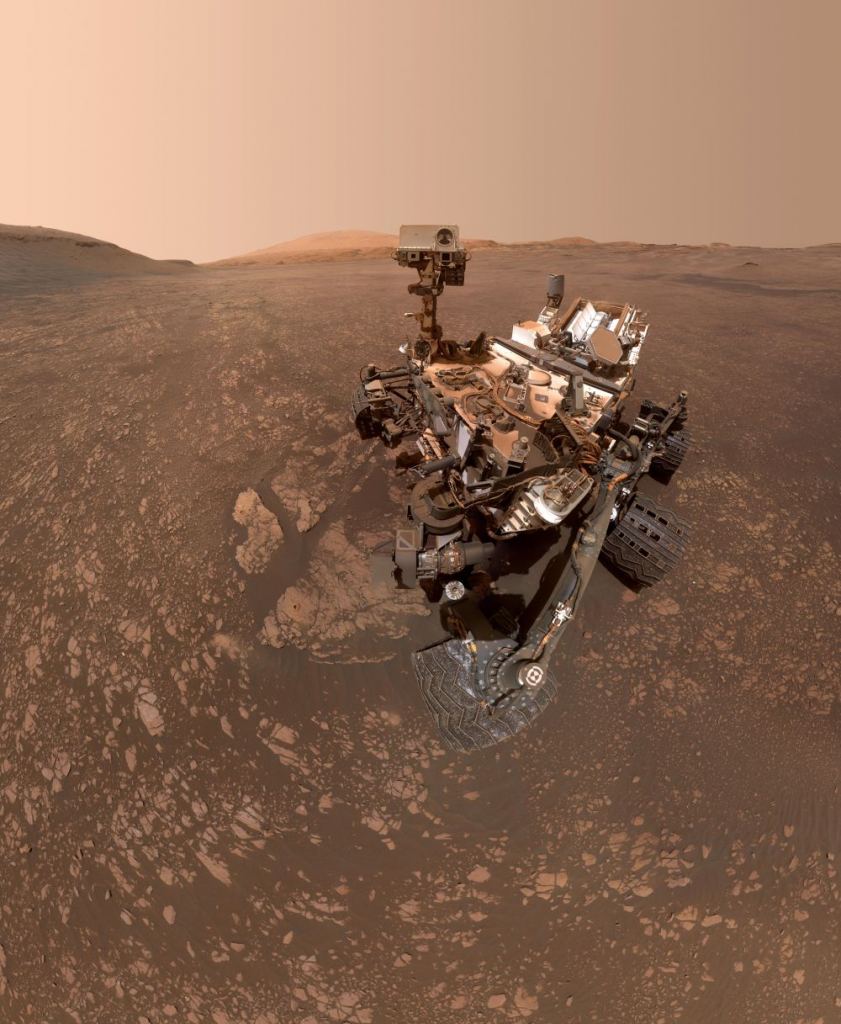We are carbon-based life forms. That means the basis for the chemical compounds that forms our life is the element carbon. It’s crucial because it bonds with other elements such as hydrogen and oxygen to create the complex molecules that are part of life.
So, when we look for evidence of life elsewhere in the solar system, we look for carbon. That includes Mars. A few years ago, the Mars Curiosity rover measured the abundance of total organic carbon in rock samples it took in Gale Crater.
The amounts it found are higher than in rocks from some of the driest areas on Earth. The question now is whether Curiosity’s measurement indicates the presence of life-creating compounds. Or, could the carbon have come from other non-organic sources? Either way, its presence unveils an interesting chapter in Mars’s past.
The Search for Carbon The Mars Curiosity Rover’s mission is, in large part, to find evidence of life and habitability on Mars. It does that by studying the chemical and geological environment on the surface. In particular, it helps unveil what role water has played in the past.
Its measurement of total organic carbon is part of that mission. Knowing the carbon species on Mars helps scientists understand how they may have formed. Total organic carbon is special because it’s a crucial part of life’s recipe.
Scientists studied Mars rocks dug up in 2014 to see if they could figure out what the abundance of this element means for the existence of life on ancient Mars. The Key to Life What’s so important about organic carbon? According to scientist Jennifer Stern, Curiosity’s finding helps scientists understand important factors about Mars and its life-bearing capability. “Total organic carbon is one of several measurements [or indices] that help us understand how much material is available as feedstock for prebiotic chemistry and potentially biology,” Stern said in a press release statement.
Stern works at NASA’s Goddard Space Flight Center in Greenbelt, Maryland. She specializes in studies of the surface and atmospheric chemistry of Mars. Her team used data provided by the Sample Analysis at Mars instrument onboard Curiosity to characterize carbon species on Mars.
“We found at least 200 to 273 parts per million of organic carbon,” she reported. “This is comparable to or even more than the amount found in rocks in very low-life places on Earth, such as parts of the Atacama Desert in South America, and more than has been detected in Mars meteorites. ” Curiosity Baked Rocks to Get Organic Carbon This mosaic of images from Curiosity’s Mast Camera (Mastcam) shows geological members of the Yellowknife Bay formation.
This region is where the rover dug for rocks to look for carbon isotopes. The rocks here record superimposed ancient lake and stream deposits that offered past environmental conditions favorable for microbial life. Rocks here were exposed about 70 million years ago by the removal of overlying layers due to erosion by the wind.
Courtesy NASA/JPL-CalTech/MSSS To make its measurement, Curiosity delivered powdered rock to its Sample Analysis at Mars (SAM) instrument for further study. An onboard oven heated the sample to progressively higher temperatures. The experiment used oxygen and heat to convert the element to carbon dioxide (CO2).
The 2014 process preceded years of analysis before the science team could understand the results and put them in the context of the mission’s other findings. The discovery of organic carbon on Mars is not new, but prior findings had limitations. To find it in Gale Crater, Curiosity took a soil sample of an area of its 3.
5-billion-year-old mudstone rocks. Mudstone, as you might suspect, begins as mud at the bottom of a lake or ocean. The place where Curiosity sampled is the Yellowknife Bay formation in Gale Crater.
It contained a lake several billion years ago. Organic carbon was part of the material that settled down to the lake bottom to make the mudstone. Discerning Different Species of Carbon in the Mars Rocks Beyond simply finding the high abundances of organic carbon in Mars rocks, the experiment also allowed SAM to measure its isotope ratios.
These are chemical analyses that help pinpoint the source of the element. Isotopes are versions of an element with slightly different weights due to the presence of one or more extra neutrons in the center (nucleus) of their atoms. For example, carbon-12 has six neutrons while the heavier carbon-13 has seven neutrons.
Since heavier isotopes react more slowly than lighter isotopes, the carbon from life is richer in carbon-12. The presence of organic carbon is not necessarily definitive proof of life, according to Stern. However, it does provide other tantalizing information.
“In this case, the isotopic composition can really only tell us what portion of the total carbon is organic carbon and what portion is mineral carbon,” said Stern. “While biology cannot be completely ruled out, isotopes cannot really be used to support a biological origin for this carbon, either, because the range overlaps with igneous (volcanic) carbon and meteoritic organic material, which are most likely to be the source of this organic carbon. ” So, even though the total organic carbon measured does not definitively prove life existed on Mars, it’s one more clue to the vanished ancient Martian environment.
Gale Crater had chemical energy sources (which feed many microbial life forms) and low acidity. Other elements essential for biology, such as oxygen, nitrogen, and sulfur existed there. “Basically, this location would have offered a habitable environment for life, if it ever was present,” said Stern, who is the lead author of a paper about this research published June 27 in the Proceedings of the National Academy of Sciences.
For More Information NASA’s Curiosity Takes Inventory of Key Life Ingredient on Mars Organic carbon concentrations in 3. 5-billion-year-old lacustrine mudstones of Mars The post Curiosity Finds Life-Crucial Carbon in Mars Rocks appeared first on Universe Today. .
From: universetoday
URL: https://www.universetoday.com/156497/curiosity-finds-life-crucial-carbon-in-mars-rocks/



